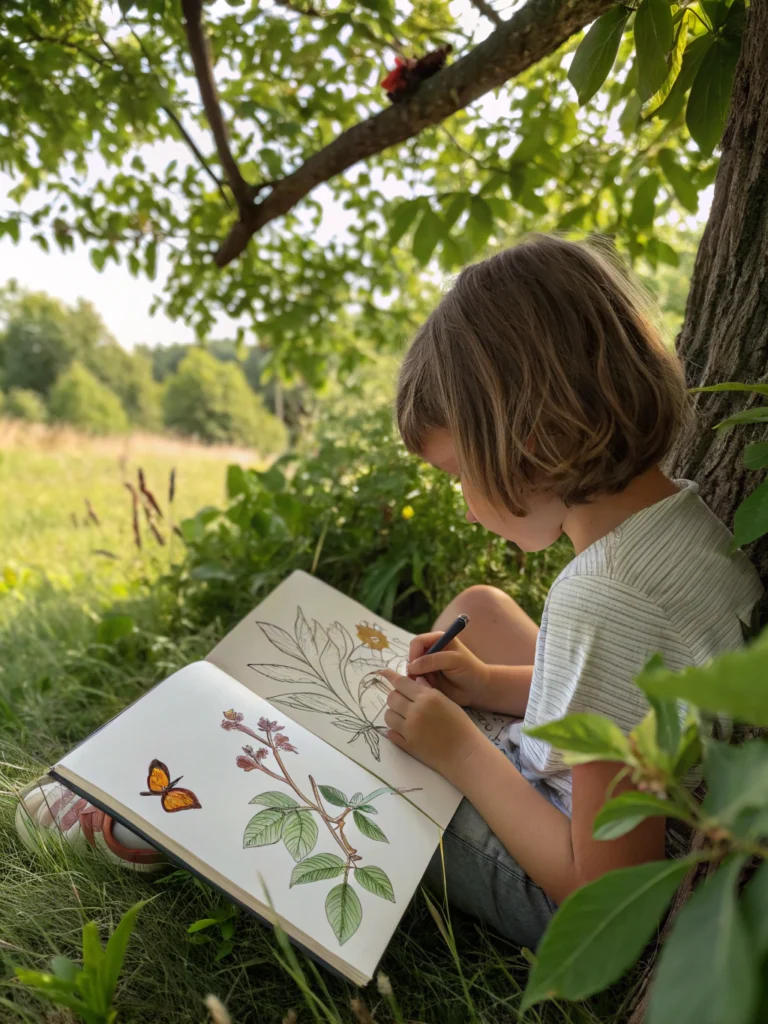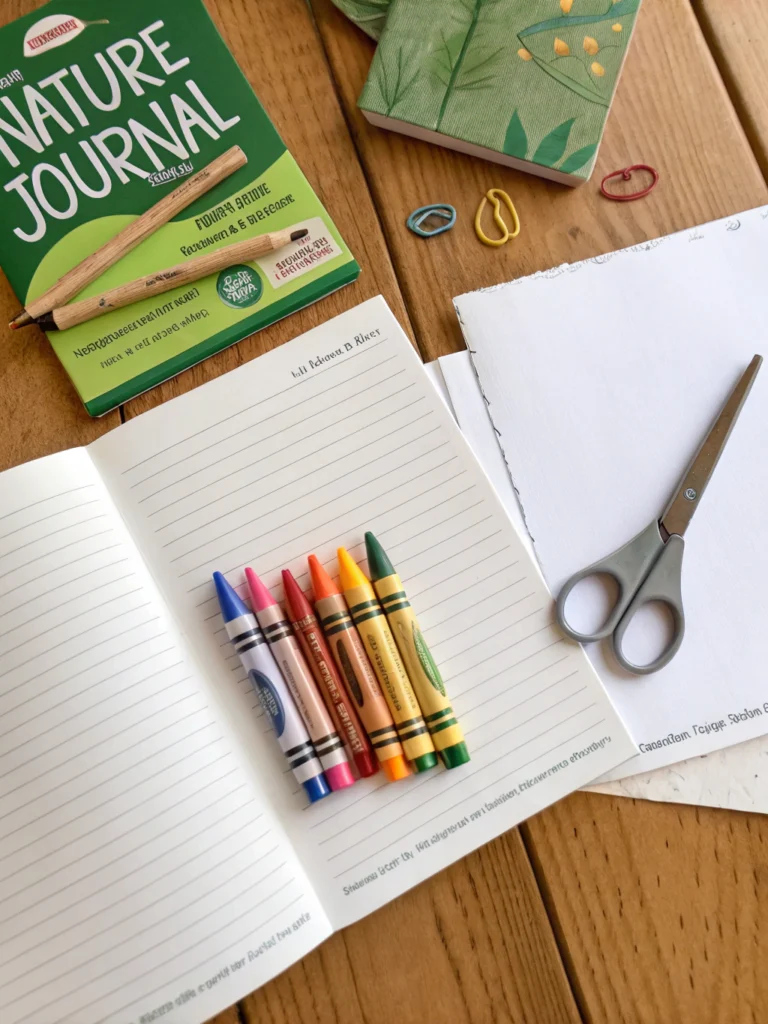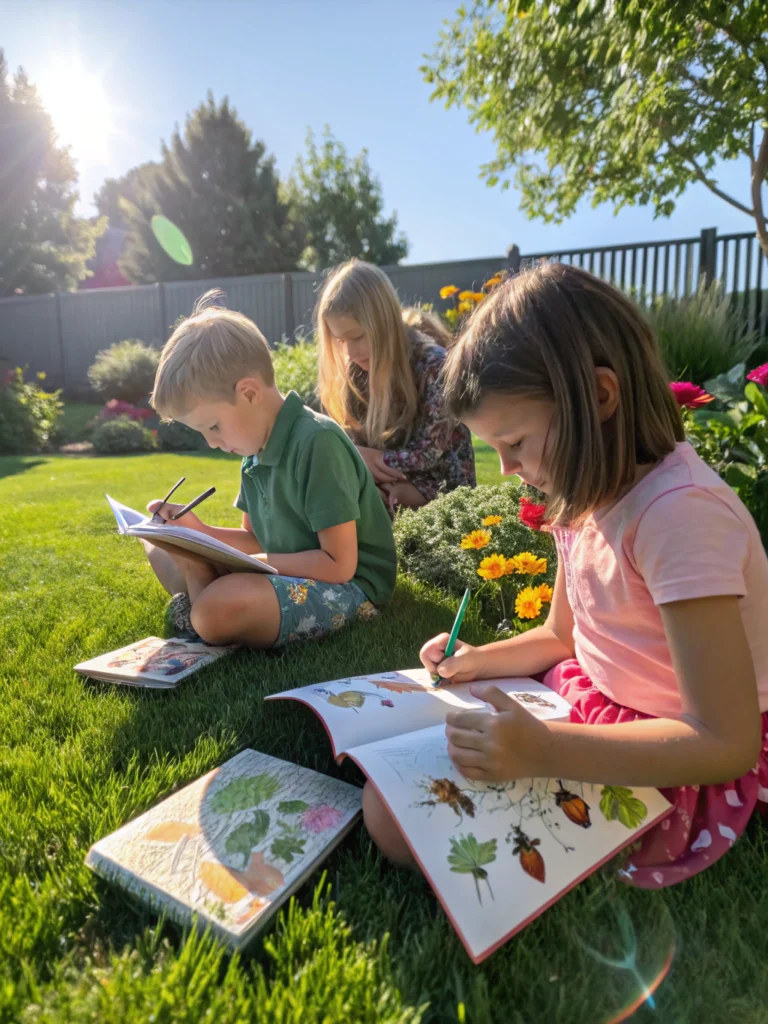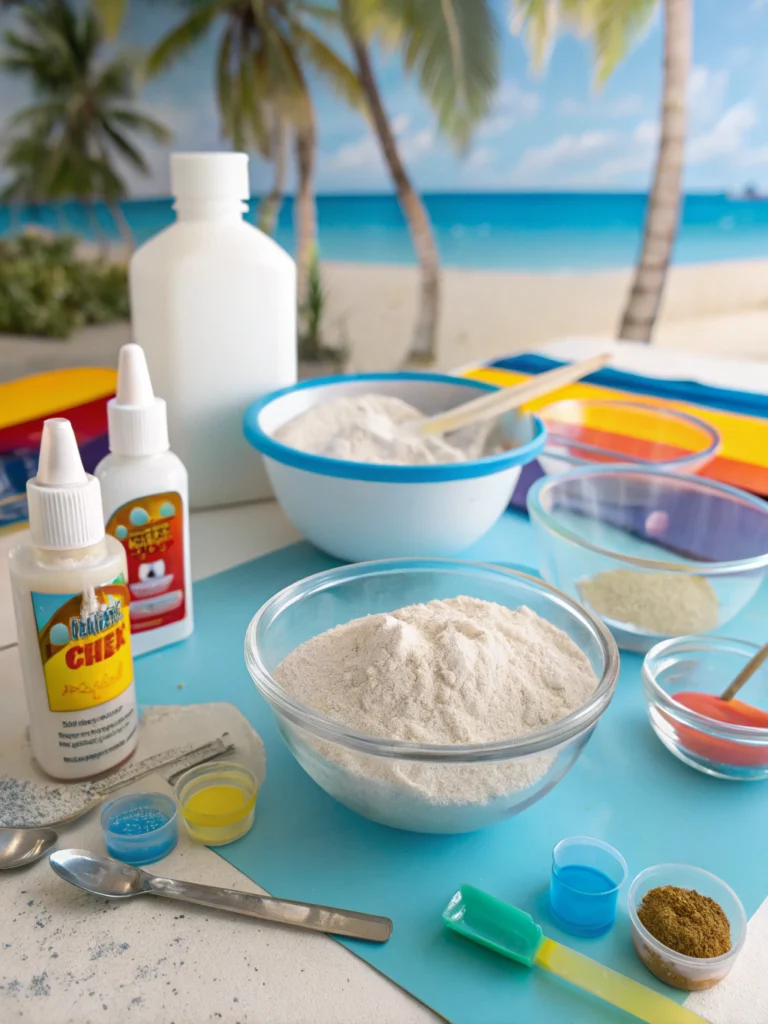Introduction
Ever wondered how to pull your kids away from screens and into the great outdoors, all while sparking their creativity? Creating a diy nature journal for kids is the perfect solution! It’s a fantastic way to combine art, science, and adventure, encouraging little ones to observe, document, and appreciate the natural world around them. This isn’t just another craft project; it’s an ongoing journey of discovery that fosters a lifelong love for nature. Plus, it’s a wonderfully simple and budget-friendly activity that the whole family can enjoy. Let’s dive into how you can easily make a personalized nature journal and fill it with exciting explorations.
Table of Contents
Table of Contents

What You’ll Need to Create Your DIY Nature Journal for Kids diy nature journal for kids
Before we embark on this creative adventure, let’s gather our supplies. The beauty of a diy nature journal for kids is its simplicity. You likely have many of these items already, and the rest are easily found at your local craft store or even around your house.

Here’s a list of what you’ll need: DIY Nature Journal for Kids
- A Blank Notebook or Sketchbook: Choose one with sturdy paper that can handle a bit of glue, paint, or pressed flowers. A5 or A6 size is usually perfect for little hands.
- Plain Paper or Cardstock: For extra pages, or if you’re making the journal from scratch.
- Cardboard or Thick Cardstock: For the covers, if you’re binding your own journal.
- Decorative Paper: Think scrapbook paper, old maps, or even fabric scraps to personalize the cover.
- Binding Materials:
- Hole Punch
- String, Twine, or Ribbon: For a simple tied binding.
- Alternatively, Stapler (heavy-duty if using many pages) or Book Rings.
- Adhesives:
- PVA Glue or Glue Stick
- Double-sided Tape (optional, but handy for neatness)
- Cutting Tools:
- Child-Safe Scissors
- Craft Knife (for adult use only, if cutting thick cardboard)
- Decorating Supplies:
- Markers, Crayons, Colored Pencils
- Stickers (nature-themed are great!)
- Washi Tape
- For Collecting Specimens (Optional, with care):
- Small Envelopes or Ziploc Bags: To attach to pages for holding small treasures like seeds or tiny shells.
- Ruler
- Pencil
How to Make Your DIY Nature Journal: A Step-by-Step Guide
Now for the fun part – actually making your journal! This process is as much a part of the adventure as using the journal itself. We’ll break it down into five core “ideas” or stages, which also serve as your steps.
Idea 1: Crafting the Journal Covers (Step 1) DIY Nature Journal for Kids
The cover is the first thing your little explorer will see, so let’s make it inviting! This is where their personality can really shine.

First, decide on your cover material. If you’re using a pre-made notebook, you can skip cutting cardboard and go straight to decorating. If you’re making covers from scratch, cut two pieces of sturdy cardboard or thick cardstock to your desired journal size. Remember to make them slightly larger than your internal pages to protect them.
Next, let your child decorate these covers. They could paint them, cover them with decorative paper, create a collage of pressed leaves (once dried!), or draw their favorite nature scenes. Encourage them to use natural elements if they wish, like gluing on a flattened, dried leaf or a small, smooth twig. This step is crucial for ownership; a journal they decorated themselves will feel much more special. A common pitfall here is using too much wet glue on thin paper, causing it to warp – opt for glue sticks or apply PVA glue thinly.
Idea 2: Preparing and Assembling the Pages (Step 2)
The heart of any journal is its pages. For a nature journal, blank pages offer the most freedom for drawing, writing, and sticking in found treasures.
Gather your chosen paper. Standard printer paper works, but slightly thicker drawing paper or mixed-media paper is even better as it will hold up to various art supplies and glued items. Decide on the number of pages – 20-30 sheets (which will make a 40-60 page journal when folded) is a good starting point. You can always add more later if your binding method allows.
If you’re making the journal from scratch, fold your sheets of paper in half to create the booklet shape. If using single sheets with a pre-made notebook or planning a ring binding, ensure all pages are the same size. Now, if you’re using a string or ring binding, carefully align your pages and covers and use the hole punch. For a simple two-hole or three-hole punch, mark the spots evenly. Accuracy here is key to a neat finish. For a more in-depth look at different binding techniques, you might find some inspiration looking at other diy nature journal for kids projects.
Idea 3: Binding Your Nature Journal (Step 3)
Binding brings it all together! There are several kid-friendly ways to do this.
For a simple string binding, thread your twine or ribbon through the holes. You can do a simple loop and tie on the outside, or try a pamphlet stitch for a more secure binding if you’re feeling adventurous. Ensure the string is pulled taut enough to hold the pages securely but not so tight that it tears the paper.
Alternatively, book rings are incredibly easy and allow for pages to be added or removed later – perfect for an evolving journal. Just pop them through the holes. If you opted for folding pages into signatures (booklets), you could use a long-arm stapler down the center fold, or even sew them together using a needle and strong thread (an adult job). The chosen method depends on the age of the child and the materials you have.
Idea 4: Adding Special Touches and Pockets (Step 4)
This is where we elevate the journal from a simple notebook to a real explorer’s companion. Adding pockets or envelopes can be incredibly useful for Diy nature journal activities.
Consider gluing small paper envelopes or creating folded paper pockets onto some of the inside pages. These are perfect for holding delicate items like feathers, small pressed flowers, seeds, or tiny shells that might otherwise get lost or damaged. You can make these from scraps of paper or use ready-made small coin envelopes.
Another fun addition is a bookmark ribbon. Glue one end of a length of ribbon to the inside of the back cover before you fully secure it (if applicable, depending on your binding). Washi tape can also be used to create decorative borders on pages or to tape in small, flat items. These little details make the journal more interactive and functional for young naturalists working on their Kids nature journal projects. DIY Nature Journal for Kids
Idea 5: Inspiring First Entries & Journal Prompts (Step 5)
Now that the physical journal is complete, it’s time to think about how to start filling it! The first page can sometimes be daunting.
Help your child make their first entry. This could be as simple as writing their name and the date, or drawing a picture of what the weather is like today. You could also create a “Nature Explorer ” page with a self-portrait in their outdoor gear. Providing some initial prompts can be very helpful, especially when figuring out How to start a nature journal for children.
Consider writing a few prompts on the first few pages, or on a separate ideas list tucked into a pocket:
- “Today I saw…” DIY Nature Journal for Kids
- “My favorite sound in nature is…” DIY Nature Journal for Kids
- “Draw a leaf you found and describe its texture.” DIY Nature Journal for Kids
- “What insects did you spot? Can you draw one?” DIY Nature Journal for Kids
- “Press a flower or leaf here.” (Make sure they know how to press them properly first – between sheets of newspaper inside a heavy book for a week or two). DIY Nature Journal for Kids
These prompts guide their observations and encourage them to think more deeply about what they’re experiencing. You can find many more ideas for “Diy nature journal activities, Kids nature journal projects, How to start a nature journal for children” online, which can offer fantastic inspiration for varying ages and interests.
Your Completed DIY Nature Journal for Kids!
Voilà! Your child now has their very own, personalized diy nature journal for kids, ready for countless outdoor adventures.

This journal is more than just a craft; it’s a tool for learning, a keepsake of childhood discoveries, and a wonderful C. It encourages observation skills, scientific curiosity, artistic expression, and a deep appreciation for the natural world. Imagine them looking back on these pages years from now!
We’d love to see what amazing diy nature journal for kids you and your little explorers create! Share your pictures and tips in the comments below. What are your child’s favorite things to record in their nature journal?
Pro Tips & FAQs for Your DIY Nature Journal Journey
To help you make the most of this project, here are some extra tips and answers to frequently asked questions.
What are the best items to collect for a nature journal?
Focus on things that are flat or can be flattened easily. Great options include leaves of different shapes and sizes, thin petals from flowers (ensure they are not from protected species or private property), small, flat seeds, bark rubbings (place paper over bark and rub with the side of a crayon), and feathers (if found ethically). Avoid collecting anything living or disturbing habitats. Always supervise children and teach them to respect nature while collecting. These collections can become fun **Diy nature journal activities**.
How can I encourage my child to use their nature journal regularly?
Make it a routine, but keep it fun and pressure-free! Maybe dedicate a “Nature Journaling Friday” afternoon or a short session after every park visit. Lead by example – perhaps you could start your own nature journal too! Offer new prompts or themes, like focusing on insects one week, and trees the next. Highlighting their interesting finds or beautiful drawings also provides positive reinforcement. Making it part of your **Kids nature journal projects** can turn it into a cherished family activity.
What if my child isn’t a strong writer or artist?
A nature journal is for everyone! Emphasize that it’s about observation and personal expression, not artistic perfection or perfect spelling. For younger children, they can dictate their observations to you, and you can write them down. They can also focus on tracing leaves, making bark rubbings, or simply gluing in found items. Stickers can also be a fun way to decorate pages. The key is to make it an enjoyable process of discovery. Understanding **How to start a nature journal for children** includes adapting to their individual skill levels.
How do I properly press flowers and leaves for the journal?
Collect flowers and leaves when they are dry (not dewy or wet from rain). Place them between two sheets of absorbent paper, like newspaper or blotting paper. Then, put these inside a heavy book or a flower press. Ensure they are flat and not overlapping. Leave them for 1-3 weeks, checking occasionally. Once completely dry and papery, they can be carefully glued or taped into the journal. This is a classic element of many **Diy nature journal activities**.
Can we make a digital nature journal instead?
Absolutely! While a physical **diy nature journal for kids** has a wonderful tactile appeal, a digital version can also be very engaging. Kids can take photos of their finds, record nature sounds or short videos, and use drawing apps to sketch what they see. They can then compile these into a digital slideshow, a blog, or a document. This can be a great option for tech-savvy kids or for documenting things you can’t physically collect, like animal sightings. Explore various educational apps or even simple presentation software for this. For more ideas on incorporating digital elements or finding diverse [“Diy nature journal activities, Kids nature journal projects, How to start a nature journal for children”](https://www.hgtv.com/design/make-and-celebrate/handmade/our-65-favorite-handmade-holiday-decorating-ideas-pictures), resources abound online.
We hope this guide has inspired you to create a diy nature journal for kids and foster a deeper connection with the outdoors. It’s a rewarding project that offers endless possibilities for learning and fun.
What are you waiting for? Grab your supplies and head outside! DIY Nature Journal for Kids
Don’t forget to share your creations and experiences in the comments below. We love hearing from fellow DIY enthusiasts! For more creative DIY ideas, be sure to check out our other projects and sign up for our newsletter for regular inspiration delivered straight to your inbox. Happy journaling!


